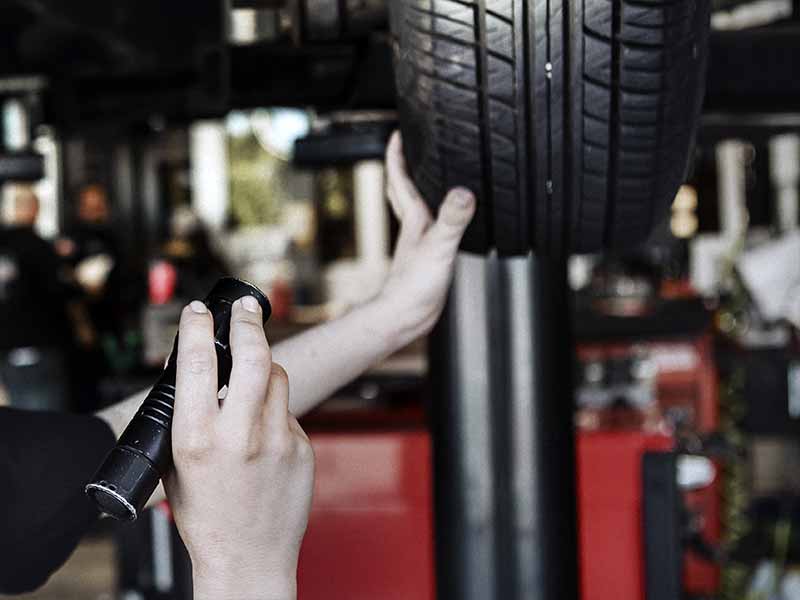You’ve likely heard the terms tire rotation, balancing, and alignment thrown around in auto shops or car enthusiast circles. But what do they really mean, and more importantly, why should you care?
Tire Rotation Vs Balancing Vs Alignment
Tire rotation, balancing, and alignment are essential maintenance practices for vehicles; rotation ensures even tire wear, balancing corrects weight distribution for smooth driving, and alignment adjusts wheel angles for optimal contact with the road.
In this article, we delve into the details of tire rotation, balancing, and wheel alignment, explaining how each process contributes to even tread wear and extends the life of your tires.
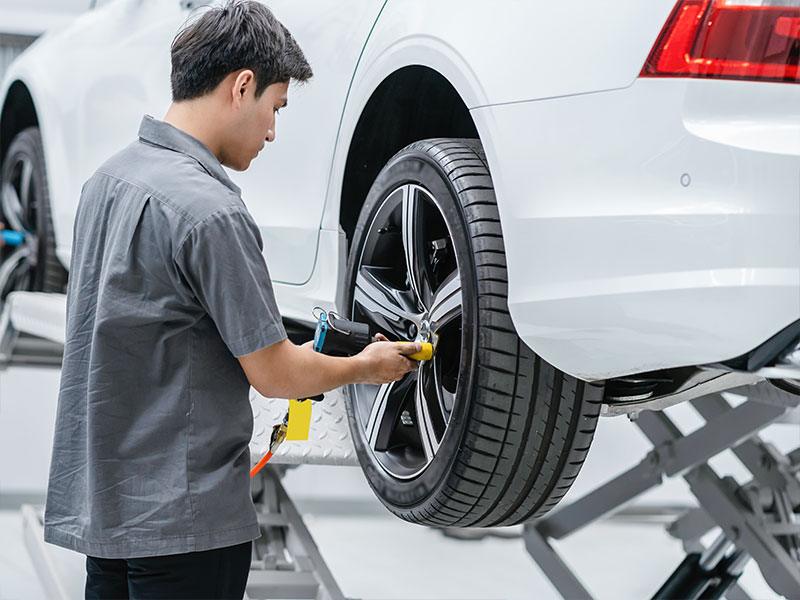
Understanding Tire Rotation
Tire rotation might sound like something best left to the professionals, but it’s actually a key part of tire maintenance that every car owner should be familiar with. Let’s dive into what tire rotation is, why it’s crucial, and how it’s done.
Definition and Purpose of Tire Rotation
What is Tire Rotation?
- Essentially, tire rotation involves moving your tires from one position on your vehicle to another.
- This practice is crucial for ensuring even tire wear. Why? Because each tire on your vehicle wears differently depending on its position.
The Role of Tire Rotation in Tire Care
- Regular tire rotation helps distribute the wear more evenly across all tires.
- It’s not just about prolonging the life of your tires, though that’s a big part of it. It’s also about maintaining good handling and traction.
- Curious about the nitty-gritty of tire rotation? Learn more about what tire rotation entails.
How Tire Rotation is Performed
There’s no one-size-fits-all pattern for rotating tires; it can vary based on your vehicle type, tire type, and driving habits. However, some common rotation patterns include:
- Front-to-back: Moving the front tires to the rear and vice versa.
- Side-to-side: Swapping the tires on the left side of the vehicle with those on the right.
- Diagonal rotation: A mix of the above, often used for vehicles with different-sized tires on the front and rear.
Wondering how long this process takes or what it might cost you? These details about tire rotation time and cost can give you a clearer picture.
Benefits of Regular Tire Rotation
Why should you make tire rotation a part of your regular vehicle maintenance routine?
- Extended Tire Life: Rotating your tires helps them wear evenly, which means they’ll last longer. That’s good news for your wallet and the environment.
- Improved Performance: Evenly worn tires provide better traction and handling, which translates to a smoother, safer ride.
- Reduced Stress on Your Vehicle: When tires wear evenly, it lessens the strain on your vehicle’s suspension components, helping to maintain its overall health.
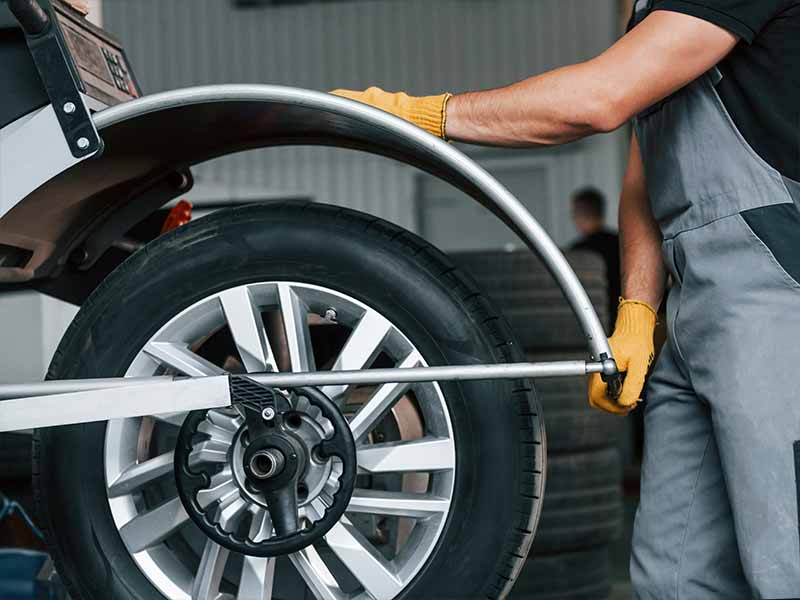
The Essentials of Tire Balancing
Moving beyond tire rotation, let’s get into another vital aspect of tire maintenance: tire balancing. It’s not just a fancy term used by mechanics; it’s an integral part of ensuring your ride is smooth and your tires last as long as possible.
What is Tire Balancing?
The Basic Concept
- Tire balancing is all about ensuring that the weight of the tire is evenly distributed around the axle.
- An unbalanced tire can lead to vibrations, uneven tire wear, and additional strain on your vehicle.
Impact on Vehicle Performance
- Think of it like this: when a tire is off-balance, it doesn’t rotate as smoothly. This imbalance can lead to a range of problems, from annoying vibrations in the steering wheel to accelerated wear on your suspension.
Curious about the details? Dive deeper into what tire balancing involves.
Process of Balancing Tires
So, how do professionals balance tires? It’s a bit more complex than tire rotation, but here’s a simplified breakdown:
- Mounting the Tire on a Balancer: This special machine spins the tire to determine where the imbalances are.
- Identifying Imbalance: The machine pinpoints the lighter or heavier areas of the tire.
- Adding Weights: To counterbalance these areas, small weights are meticulously added to the rim.
Wondering about the time and cost involved in this process? Check out the cost and duration of tire balancing.
Advantages of Properly Balanced Tires
Why is tire balancing not something to skip on your maintenance list?
- Smooth Riding: One of the first signs of unbalanced tires is a vibrating steering wheel. Balancing your tires eliminates this vibration, making your drive more comfortable.
- Uniform Tire Wear: Balanced tires wear more evenly, which means you won’t have to replace them as often.
- Optimized Performance: Properly balanced tires enhance vehicle handling and fuel efficiency.
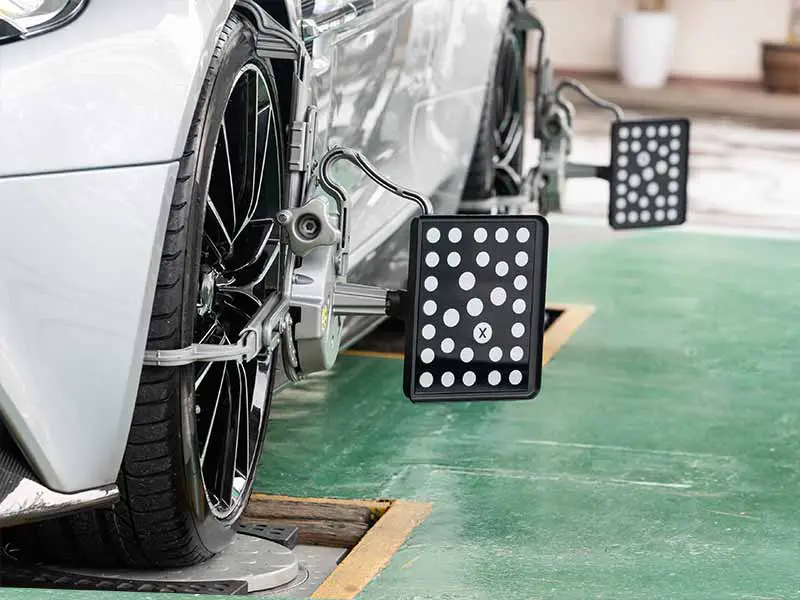
Wheel Alignment Explained
Now, let’s steer into the realm of wheel alignment – a crucial factor often overshadowed by the more talked-about tire rotation and balancing. But make no mistake, proper alignment is just as vital for your vehicle’s health and your tires’ longevity.
Understanding Wheel Alignment
What Does Wheel Alignment Involve?
- Wheel alignment, contrary to some beliefs, isn’t about adjusting the tires or wheels themselves. It’s about adjusting the angles of the wheels so they’re set to the car manufacturer’s specifications.
- Proper alignment ensures that your tires make contact with the road at the right angle, promoting even tire wear and optimal handling.
Impact on Tire Wear and Vehicle Handling
- Misaligned wheels can lead to uneven tire wear, poor handling, and can even affect fuel efficiency.
- Learn more about the importance of wheel alignment in this detailed guide.
Signs of Misalignment
How do you know if your wheels need alignment? Look out for these tell-tale signs:
- Uneven Tire Wear: If one side of your tire is wearing out faster than the other, it’s a red flag.
- Vehicle Pulling to One Side: If your car drifts to one side when you’re driving straight, it’s time for a check-up.
- Steering Wheel Vibration or Misalignment: A vibrating steering wheel or one that doesn’t stay centered is a sign of trouble.
The Process of Aligning Wheels
Wheel alignment is a task for the professionals, involving high-tech equipment and precision. Here’s a simplified overview:
- Inspection of Suspension Components: Before alignment, mechanics often check for worn parts which could affect the alignment.
- Measuring Angles: Using specialized equipment, technicians measure the camber, toe, and caster angles.
- Adjustments: Based on these measurements, adjustments are made to bring the wheels into the correct alignment.
Curious about how long a wheel alignment takes or what it might cost? This link provides valuable insights into the duration and cost of wheel alignment.
Benefits of Regular Wheel Alignment
Investing in regular wheel alignment pays off in several ways:
- Extended Tire Life: Proper alignment prevents premature tire wear, saving you money in the long run.
- Improved Fuel Efficiency: Aligned wheels reduce rolling resistance, which can improve your car’s fuel economy.
- Enhanced Safety and Handling: A well-aligned vehicle is safer to drive, offering better handling and stability.

How Tire Rotation, Balancing, and Alignment Work Together
Having explored the individual roles of tire rotation, balancing, and alignment, it’s time to see the bigger picture. How do these three maintenance tasks work in concert to keep your tires in top shape and your ride smooth? Let’s connect the dots.
The Interconnectivity of Tire Maintenance
A Balanced Relationship
- Think of your vehicle’s tires and wheels as members of a team, each relying on the others to perform at their best.
- Tire rotation ensures even wear, balancing combats vibration and unevenness, and alignment keeps your vehicle moving straight and true.
- Ignoring one aspect can throw off the others, leading to quicker wear and tear and potential safety issues.
Complementary Maintenance Practices
Tire Rotation and Balancing
- Regular rotation can help identify balance issues early on, as changing tire positions can sometimes reveal vibrations or other problems.
- It’s often recommended to balance your tires each time they’re rotated for optimal performance.
Tire Balancing and Alignment
- Balancing your tires without proper alignment is like trying to fine-tune a guitar with loose strings. It might help a bit, but the underlying issue remains.
- Similarly, aligning your wheels without addressing any existing balance issues won’t ensure smooth driving.
Alignment and Rotation
- Wheel alignment can affect how your tires wear. If your tires aren’t aligned correctly, even regular rotation can’t prevent uneven wear.
- Conversely, rotating your tires can sometimes highlight alignment problems, like if your car starts pulling to one side after rotation.
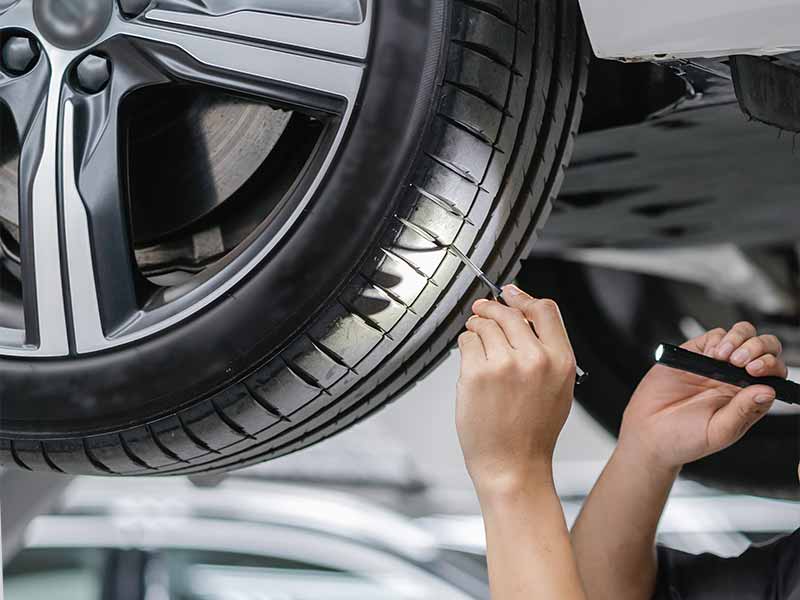
Maintenance Schedule and Recommendations
You’re now well-versed in the what, why, and how of tire rotation, balancing, and alignment. But the real key to ensuring your tires live a long and healthy life lies in sticking to a consistent maintenance schedule. Let’s break down a practical approach to managing these crucial services.
Suggested Maintenance Schedule
Tire Rotation:
- Frequency: Every 5,000 to 8,000 miles is a standard recommendation, but always check your vehicle’s manual for specific guidance.
- Tip: A good practice is to rotate your tires with every oil change, as the mileage intervals often align.
Tire Balancing:
- Frequency: Balance your tires whenever you get them rotated, or if you start to notice vibrations or uneven wear.
- Reminder: Balancing is not just a one-time task. It should be done periodically throughout the life of your tire.
Wheel Alignment:
- Frequency: At least once a year, or sooner if you notice any signs of misalignment.
- Note: Hitting potholes or curbs can throw off your alignment, so it’s wise to get it checked after any such incidents.
Practical Tips for Tire Maintenance
Stay Proactive:
- Regular Checks: Make it a habit to visually inspect your tires for wear and tear, and keep an eye out for any changes in your vehicle’s handling.
- Pressure Checks: Don’t forget about tire pressure! Proper inflation is crucial for tire longevity and performance.
Recognizing When Service is Necessary:
- Listen and Feel: Pay attention to any unusual noises, vibrations, or changes in your vehicle’s driving dynamics.
- Visual Cues: Uneven tread wear or your car pulling to one side can be indicators that it’s time for maintenance.
Leveraging Professional Help:
- Expert Insight: Regular visits to a trusted mechanic can help catch issues early and provide specific advice tailored to your vehicle and driving habits.
- Invest in Quality Service: Skimping on tire services can cost more in the long run. Choose reputable service providers for the best care of your vehicle.
Resources
Below are some links you may find helpful when learning about tires:
- Tire rotation: How and why to rotate your tires – Bridgestone
- Tire balancing – Discount Tire
- What is wheel alignment – Kelly Blue Book
Final Thoughts
We’ve covered the critical aspects of tire rotation, balancing, and alignment. Each plays a pivotal role in ensuring your vehicle’s tires wear evenly, perform at their best, and last as long as possible.
Regular tire rotation prevents uneven wear, balancing ensures a smooth ride free from vibrations, and proper alignment is key to maintaining the right contact between your tires and the road.
By understanding and adhering to a regular maintenance schedule for these three practices, you can improve your vehicle’s performance, safety, and efficiency.
Good luck and happy motoring.
